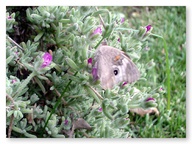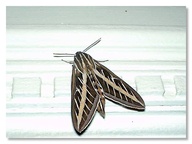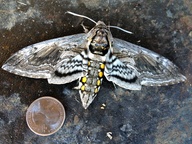 Western Tiger Swallowtail Many of those soft wormy things munching on your garden may turn into a moth or butterfly one day soon. Depending on your perspective, Davis enjoys a relatively healthy sampling of Lepidoptera, or butterflies and moths. Before going on about the details of this huge order, it is worth noting that UC Davis claims as its own one of the world's foremost authorities on butterflies Art Shapiro, who sponsors the annual Butterflies for Beer competition. Another place to learn about butterflies and moths is the Bohart Museum of Entomology.
Western Tiger Swallowtail Many of those soft wormy things munching on your garden may turn into a moth or butterfly one day soon. Depending on your perspective, Davis enjoys a relatively healthy sampling of Lepidoptera, or butterflies and moths. Before going on about the details of this huge order, it is worth noting that UC Davis claims as its own one of the world's foremost authorities on butterflies Art Shapiro, who sponsors the annual Butterflies for Beer competition. Another place to learn about butterflies and moths is the Bohart Museum of Entomology.
Butterflies used to be distinguished from moths in that they flew during the day, possessed clubbed antennae, were brightly colored, and lacked a frenulum (a wing coupling mechanism found in most moths). There is now a group of tropical American "moths," however, that are thought to be more closely related to butterflies than to moths despite being nocturnal and lacking the clubbed antennae of other butterflies. Exceptions in the way Lepidoptera are classified suggest that the distinction between butterflies and moths can be somewhat subjective.
Many birds and some insects eat butterfly/moth larvae, while bats, birds, small rodents, reptiles, amphibians, spiders, and predatory insects all eat the adults. Because of this high predation rate, the average female butterfly can lay over 100 eggs. Unfortunately for the butterfly, it's main purpose is to be food for almost everything around it. Both larval and adult butterflies and moths are often highly colored, and adult butterflies typically live only about two weeks, with the exception of the monarch butterfly which lives two to four times longer in order to complete its seasonal migration. Santa Cruz boasts a huge Monarch Butterfly habitat within one of its eucalyptus groves.
Butterflies You May See Locally
| Common Name | |||
| Taxonomic classification | |||
| Adult Plant Preference | |||
| Larval Plant Preference | |||
| Monarch | |||
| (Danaus plexippus) | |||
| Milkweed, lantana, lilac, cosmos, goldenrod, zinnia | |||
| Milkweed | |||
| The Anise Swallowtail | |||
| (Papilio zelicaon) | |||
| Lantana, zinnia, butterfly bush, lily-of-the-nile | |||
| Carrot, fennel, anise, parsley | |||
| European Cabbage Butterfly | |||
| (Pieris rapae) | |||
| Lantana, impatiens, marigold, mints, dandelion | |||
| Cabbage, cauliflower, broccoli, radish, nasturtium | |||
| Gray Hairstreak | |||
| (Strymon melinus) | |||
| Goldenrod, milkweed, clover, winter cress | |||
| Hibiscus, clover, mallow, vetch | |||
| Painted Lady | |||
| (Vanessa cardui) | |||
| Aster, cosmos, thistle, and buttonbush | |||
| Thistle, mallow, hollyhocks | |||
| Checkered Skipper | |||
| (Pyrgus communis) | |||
| Aster, fleabane, knapweed, shepherd's needle | |||
| Mallow, hollyhocks | |||
| Sachem | |||
| (Atalopedes campestris) | |||
| Marigold, aster, butterfly weed, buttonbush | |||
| Bermuda grass, crabgrass | |||
| Fiery Skipper | |||
| (Hylephila phyleus) | |||
| Statice, aster, lantana, marigold, ironweed | |||
| Bermuda grass and crabgrass | |||
should be added Tiger Swallowtail, Pipevine Swallowtail, Acmon Blue, Pygmy Blue, Alfalfa Sulfur. could be added Mourning Cloak, Buckeye, Gulf Fritillary, (Sad) Duskywing Skipper, Red Admiral.
See also The Homeless Professor & Butterflies for Beer and check out the Official Local Butterfly List.








